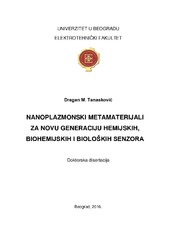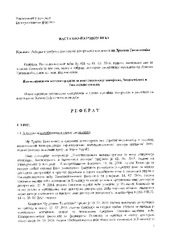Nanoplazmonski metamaterijali za novu generaciju hemijskih, biohemijskih i bioloških senzora
Nanoplasmonic metamaterials for a new generation of chemical, biochemical and biological sensors
| dc.contributor.advisor | Jakšić, Zoran | |
| dc.contributor.other | Tadić, Milan | |
| dc.contributor.other | Radovanović, Jelena | |
| dc.contributor.other | Radulović, Katarina | |
| dc.contributor.other | Čukarić, Nemanja | |
| dc.creator | Tanasković, Dragan | |
| dc.date.accessioned | 2019-02-04T12:29:39Z | |
| dc.date.available | 2019-02-04T12:29:39Z | |
| dc.date.issued | 2016 | |
| dc.identifier.uri | http://eteze.bg.ac.rs/application/showtheses?thesesId=4216 | |
| dc.identifier.uri | https://fedorabg.bg.ac.rs/fedora/get/o:13920/bdef:Content/download | |
| dc.identifier.uri | http://vbs.rs/scripts/cobiss?command=DISPLAY&base=70036&RID=48085775 | |
| dc.identifier.uri | http://nardus.mpn.gov.rs/123456789/6995 | |
| dc.identifier.uri | https://cer.ihtm.bg.ac.rs/handle/123456789/2586 | |
| dc.description.abstract | Potreba za osetljivim senzorima hemijskih, biohemijskih i bioloških agensa u današnjem svetu sve je veća, od industrije, preko biomedicine, do očuvanja okoline i protivterorističke odbrane. MeĎu najosetljivijim i najsvestranijim napravama ove vrste su elektromagnetni senzori, naročito oni koji svoju funkciju zasnivaju napovršinskimplazmonima-polaritonima (surface plasmons polaritons, SPP) na meĎupovršini metal-dielektrik. Sa dolaskom nanotehnologija otvorila se mogućnost da se proizvedu metal-dielektrični nanokompoziti, čime je omogućen novi stepen slobode u dobijanju SPP senzora i stvorena nova grana elektromagnetne optike koja je nazvana plazmonika. Posebno bitan proboj predstavljaju elektromagnetni metamaterijali koji se mogu definisati kao veštačke strukture sa elektromagnetnim, odnosno optičkim osobinama, kakve se ne pojavljuju uobičajeno u prirodi. Moţda najpoznatiji primer sutzv. „levoruki“ metamaterijali, strukture čiji efektivni indeks prelamanja u odreĎenom opsegu talasnih duţina dostiţe negativne vrednosti.Ova disertacija okrenuta je razmatranju upotrebljivosti plazmonskih metamaterijala za visoko osetljive senzore hemijskih, biohemijskih i bioloških agensa. Osnovna ideja je da se kontrolisanim strukturiranjem metal-dielektričnih nanokompozita obezbedi projektovanje novih elektromagnetnih modova. Oni će se zatim iskoristiti za prevazilaţenje principskih ograničenja konvencionalnih plazmonskih senzora i povećanje njihove osetljivosti i selektivnosti.Koncept metamaterijala s jedne strane daje mogućnost inţenjeringa frekventne disperzije i time formiranja optičkih modova neostvarivih u prirodnim materijalima, a s druge dozvoljava modifikovanje prostorne disperzije, odnosno kontrolisano menjanje optičkog prostora (tzv. transformaciona optika). Jedna od osnovnih posledica ovoga jeste mogućnost lokalizovanja optičkog polja na duboko podtalasne domene, što dovodi do drastičnogpovećanja osetljivosti hemijskih, biohemijskih i bioloških senzora. Druga posledica je mogućnost formiranja plazmonskih nanokompozita koji uvoĎenjem novih modova omogućuju selektivno očitavanje prisustva ciljanih agensa. Najzad, u takvimvstrukturama konstrukcijski se obezbeĎuje efikasna spregasa snopom za očitavanje, što je jedan od velikih problema kod konvencionalnih SPP senzora... | sr |
| dc.description.abstract | The need for sensitive sensors of chemical, biochemical and biological analytes in the contemporary world is ever increasing, from industry, to biomedicine, to environmental protection and homeland defense. Among the most sensitive and most versatile devices of this kind are electromagnetic sensors, especially those with their function based on surface plasmons polaritons (SPP) at a metal-dielectric interface. The advent of nanotechnologies ensured a possibility to fabricate metal-dielectric nanocomposites, thus ensuring a novel degree of freedom in the fabrication of SPP and creating a new branch of electromagnetic optics, the plasmonics. An especially important breakthrough are electromagnetic metamaterials that can be defined as artificial structures with electromagnetic or optic properties which do not occur usually in nature. Maybe the best known example are the so-called "left-handed" metamaterials, the structures whose effective refractive index in a given wavelength range reaches negative values.This dissertation is dedicated to a consideration of the applicability of plasmonic metamaterials for highlysensitive sensors of chemical, biochemical and biological analytes. The basic idea is to ensure the design of new electromagnetic modes through controlled structuring of metal-dielectric nanocomposites. These modes are further used to overcome the fundamental limitations of conventional plasmonic sensors and to increase their sensitivity and selectivity.The concept of metamaterial from one side offers an opportunity to engineer the frequency dispersion and thus to design optical modes unattainable in natural materials, while from the other side it allows the modification of the spatial dispersion, i.e. controlled changing of the optical space (the so-called transformation optics). One of the main consequences is the possibility to concentrate the optical field into deep subwavelength domains, which leads to a drastic increase of the sensitivity of chemical, biochemical and biological sensors. Another consequence is the possibility to form plasmonic nanocomposites which by introducing new modes ensure selective readout ofviithe targeted analytes. Finally, the geometry of such structures ensures efficient coupling with a readout beam, which is a large problem with the conventional SPP sensors... | en |
| dc.format | application/pdf | |
| dc.language | sr | |
| dc.publisher | Универзитет у Београду, Електротехнички факултет | sr |
| dc.relation | info:eu-repo/grantAgreement/MESTD/Technological Development (TD or TR)/32008/RS// | |
| dc.relation | info:eu-repo/grantAgreement/EC/FP7/205533/EU// | |
| dc.rights | openAccess | |
| dc.rights.uri | https://creativecommons.org/licenses/by-sa/4.0/ | |
| dc.source | Универзитет у Београду | sr |
| dc.subject | nanotehnologije | sr |
| dc.subject | Nanotechnologies | en |
| dc.subject | nanofotonika | sr |
| dc.subject | plazmonika | sr |
| dc.subject | metamaterijali | sr |
| dc.subject | plazmonskisenzori | sr |
| dc.subject | hemijski i biološki senzori | sr |
| dc.subject | refraktometrijski senzori | sr |
| dc.subject | Nanophotonics | en |
| dc.subject | Plasmonics | en |
| dc.subject | Metamaterials | en |
| dc.subject | Plasmonic Sensors | en |
| dc.subject | Chemical and Biological Sensors | en |
| dc.subject | Refractometric Sensors | en |
| dc.title | Nanoplazmonski metamaterijali za novu generaciju hemijskih, biohemijskih i bioloških senzora | sr |
| dc.title.alternative | Nanoplasmonic metamaterials for a new generation of chemical, biochemical and biological sensors | en |
| dc.type | doctoralThesis | en |
| dc.rights.license | BY-SA | |
| dcterms.abstract | Јакшић, Зоран; Радуловић, Катарина; Тадић, Милан; Радовановић, Јелена; Чукарић, Немања; Танасковић, Драган; Наноплазмонски метаматеријали за нову генерацију хемијских, биохемијских и биолошких сензора; Наноплазмонски метаматеријали за нову генерацију хемијских, биохемијских и биолошких сензора; | |
| dc.identifier.rcub | https://hdl.handle.net/21.15107/rcub_nardus_6995 | |
| dc.identifier.fulltext | https://cer.ihtm.bg.ac.rs//bitstream/id/5839/Disertacija.pdf | |
| dc.identifier.fulltext | https://cer.ihtm.bg.ac.rs/bitstream/id/5840/Dragan_Tanaskovic_Referat.pdf | |
| dc.type.version | publishedVersion |



